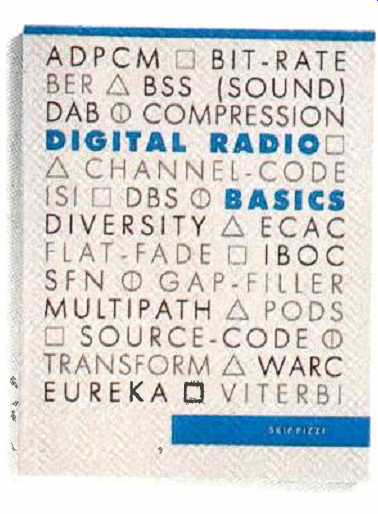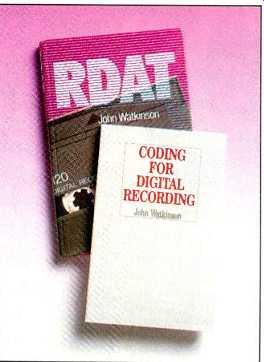NUMERIC RADIO

Digital Radio Basics by Skip Pizzi. Intertec Publishing Corp., softcover, 152 pp., $30.00.
As Brad Dick, editor of Broadcast Engineering magazine, states in his preface to this remarkably up-to-date book, "It's not often that a technology leapfrogs an entire industry in new capability. Yet, that appears about to happen almost overnight with digital radio broadcasting (DRB)." Others in the industry are referring to this new technology as DAB (Digital Audio Broadcasting) or DAR (Digital Audio Radio). Regardless of what you call it, digital radio will be with us well before the end of this decade.
In his easy-to-read and well-organized book, Skip Pizzi first explains why digital radio is a "must." He then provides a clear primer on digital audio basics, covering such topics as band width requirements, analog-to-digital conversion, binary coding, and digital signal modulation. After a brief discussion of digital radio broadcast history in Chapter 3, Pizzi leads us into the heart of the subject, data compression (or, as some prefer to call it, bit-rate reduction), in Chapter 4. The information contained in this chapter not only will clarify this subject as it relates to digital radio, but also will shed light on the data compression technologies being used in new recording formats such as the Digital Compact Cassette and the MiniDisc.
Pizzi manages to present a clear, unbiased picture of no fewer than eight proposed systems for digital radio broadcasting, categorizing them either as out-of-band formats (those that will require new spectrum allocations from the FCC) or as in-band systems (those that can use the existing broadcast spectrum in various ways).
Other chapters deal with such related topics as: Coding and error correction; the pros and cons of signal delivery by satellite, cable, and land-based broadcast stations, and the technical, economic, and political issues ahead.
A useful glossary of terms is included, as is a list of names and addresses of the principal participants--system proponents as well as associations and committees involved in the digital radio selection process. Phone numbers and FAX numbers for each of these organizations are provided so those readers wishing more detailed information can go directly to the sources.
At the end of each chapter, Pizzi provides a series of "endnotes" that either provide clarification for points made within the chapter or offer bibliographical references that will elaborate on points made by the author within the chapter.
One of the things that makes Digital Radio Basics such a joy to read is the lighthearted approach taken by the author. While the subject matter is, of course, treated with proper seriousness, each chapter is preceded by an insightful quote that sets the tone of the chapter and provides the reader with ample food for thought. A couple of examples: At the beginning of the chapter "Digital Audio Basics," the author quotes Marshall Buck (an active AES governor), who said: "Wouldn't it have been nice if George Westinghouse had chosen 64 Hz as his power line frequency?" (If you don't get the significance of that remark, you will get it after reading the chapter that follows!) To ease the concerns of those who might find the chapter on data compression somewhat "compromising," Pizzi quotes philosopher Bertrand Russell, who said: "All science is dominated by the idea of approximation." And finally, before launching into a discussion of proposed formats, the author quotes a statement by William Osler: "In science, the credit goes to the man who convinces the world, not to whom the idea first occurs." Among the most impressive aspects of this book is how amazingly up to date it is. The Electronic Industries Association has taken on the responsibility of establishing a single standard for digital radio broadcasting, at least in this country. Since that organization mandated that all system proponents submit descriptions of their system by mid-summer 1992, Pizzi was able to provide adequate description of all eight systems being proposed by the time his book was copyrighted and published in April 1992. Unlike many other technical books that are often obsolete (or at least somewhat behind the times) as soon as they are published, Pizzi's book is current on this important technology that is likely to change the course of radio broadcasting in the very near future.
Skip Pizzi is eminently qualified to author a book such as this one. He is currently technical editor for Broadcast Engineering magazine, where he covers audio and radio matters of broad cast technology. Prior to joining the magazine, he spent 13 years at Nation al Public Radio headquarters in Washington, D.C., serving in a number of different capacities, including that of technical training coordinator. Pizzi is also an active member of both the Audio Engineering Society and the Society of Broadcast Engineers and maintains a roster of consulting and training clients from around the country.
-Leonard Feldman

RDAT by John Watkinson. Focal Press, hardcover, 244 pp.,
$59.95.
Coding for Digital Recording by John Watkinson. Focal Press, softcover, 220 pp., $22.95.
Both RDAT and Coding for Digital Recording borrow heavily from John Watkinson's earlier book, The Art of Digital Audio (published in 1988 and reviewed in Audio's January 1990 is sue). The purpose of these new titles seems to be to make available in shorter form the specific topics each covers; both books offer some new material as well.
Substantial sections of RDAT are, word for word and figure for figure, taken from The Art of Digital Audio.
Chapter 1 is taken mainly from Chapter 8 of the earlier book. Chapter 2, "Con version," is entirely from Chapter 2 of The Art and is outdated. My earlier review was quite critical of this material, and the comments stand. The techniques of analog-to-digital conversion used in modern digital recording and developed extensively over the past four years are almost ignored. This chapter is the weakest and most dated in the book, in my opinion.
Chapter 3, "Digital Audio Processing," is taken mainly from Chapter 3 of The Art of Digital Audio; Chapter 4, "Digital Recording," from Chapter 6, and Chapter 5, "Error Correction," mainly from Chapter 7. Two parts of Chapter 5, Hamming distance (Section 5.8, which now includes the Venn diagram) and Introduction to error correction in RDAT (Section 5.15), are largely rewritten. Section 5.15 gives a clearly written and specific application of complex error theory to the R-DAT signal-handling system. It is instructive to see the theory applied to a .specific case. Additionally, Chapter 3 includes a section on the AES/EBU interconnect (taken, in turn, from Chapter 5 of the earlier book) that is very well done and appropriately placed. Understanding digital interconnects is vital if a digital system is to work well.
My rather extensive comments about The Art of Digital Audio apply to the corresponding chapters in this book as well. The first 147 pages of RDAT have text and figures principally in common with the earlier book but nicely rearranged to concentrate attention to those issues most applicable to understanding the R-DAT recording system. If the reader has not read the earlier book, these topics are an essential build-up to the chapters which follow.
Chapter 6 ("The RDAT Tape Transport"), Chapter 7 ("The RDAT Signal System"), and Chapter 8 ("RDAT as a Data Recorder") are wonderfully well written and as up to date as one could want. These 93 pages alone make RDAT a worthy addition to the book shelf of anyone interested in digital re cording. Watkinson is at his best form in the presentations in these three chapters. I found Chapter 6, on the mechanical transport and control systems of R-DAT, very interesting. The author includes here many details on the geometry of helical-scan recording, the mechanics of the transport, and the tracking system. His descriptions of the tape-handling motors, servo system, and alignment requirements are particularly well done. Of great interest to users of R-DAT will be the information on searching for pro gram material and the editing of the material using digital techniques. This is definitely not a razor-blade type of operation (unless the editor of the tape wishes to cut his wrists).
The material on the R-DAT digital signal system (Chapter 7) includes de tails on formats, headers, interleaving, subcode structure, and time codes specifics that any knowledgeable re cording engineer should understand if the medium is to be used to its fullest.
Indeed, this chapter is brimming with helpful information. The final chapter, which treats R-DAT as a data recorder rather than just an audio recorder, is a fine addition here. The author expands understanding of how closely digital audio and other forms of digital data handling and processing are related.
In the end, this book is a fine compilation of material from The Art of Digital Audio with extensive new material on R-DAT. It should be required reading for all those using R-DAT in any of its forms.
Coding for Digital Recording is al most completely a reprint from the original book but contains only information that is particular to the actual coding of digital information, with a number of applications presented in the final chapter.
The first four chapters are taken, with some selection and rearrangement, and essentially no new material, from chapters in The Art of Digital Audio.
Chapter 5, at 80 pages, is also taken mainly from the earlier work. There are about a dozen pages extracted from another of Watkinson's books, The Art of Digital Video, and about a dozen pages of new material on CD-ROM and other optical media.
Chapter 1 is an introduction to the need for digital recording, and Chapter 2 briefly describes magnetic and optical recording schemes in popular use.
These two chapters are both interesting and appropriate to the purpose of the book.
Chapters 3 and 4 are identical to Chapters 6 and 7 in The Art of Digital Audio. As indicated in my 1990 review, these chapters describe the heart of digital signal processing and are quite good. That is not to say that there are not some difficulties with the material presented. The writing is very compact, and some instances of major jumps in the train of thought are difficult to overcome. But as an overview and with the perspective of several years between these reviews, the new book holds up well.
In Chapter 4, "Error Correction," there is one substantially rewritten portion, Section 4.10, in which hamming distance is treated. The Venn diagram is discussed in some detail, and the back of the book has a large fold-out Venn diagram. This is a sort of coder's "centerfold," I suppose. The new material, four pages, is well written and interesting. Unfortunately, Venn did not get included in the index, an indication of a bit of haste in putting the book together.
Coding for Digital Recording is a good selection of material from the earlier book; at least 90% of it is extracted from The Art of Digital Audio. However, I would still suggest that you consider purchasing the earlier title. Although possibly twice the price, it is twice the book and all in all a far better choice for the sake of its completeness.
-R. A. Greiner
(adapted from Audio magazine, Dec. 1992)
= = = =